If I asked you what’s important in SEO, what would you answer? Content, links, and technical optimization. If yes, this is the standard answer of most SEO specialists. But there is a metric that gets little attention—CTR (Click-Through Rate). However, it impacts the success of your strategy.
CTR is essential in how users and search engines perceive your website. If people click on your page from search more often, it gets more traffic, which tells search engines that you make good quality and helpful content. But here’s the thing: even if you’ve invested a lot of effort in refining your site or writing cool texts, and your snippet in search does not attract attention – the results may disappoint you.
Usually, CTR is mentioned only in the context of advertising campaigns or when analyzing paid traffic. However, this indicator is significant for organic traffic as well. Studies increasingly prove that high CTR helps not only attract more people to the site but also improve positions in search results. So, if you want to achieve great results, it’s worth working on every element that affects clickability.
In this article:
- What is CTR in SEO?
- Why CTR Complements Rankings in Measuring SEO Success
- CTR Signals to Search Engines
- Effective Strategies to Increase CTR with SEO Improvements
- Measuring and Monitoring CTR
- What is a “Good” Click-Through Rate?
- Buddler SEO CTR Benchmarks Report
- Analyze CTR Anomalies to Refine SEO Strategy
1. What is CTR in SEO?
Click-Through Rate (CTR) is a key metric in SEO that indicates the frequency users click on a link after it appears in search engine results pages (SERPs). The higher the CTR, the more effectively your content attracts users to click on your website.
Here is how to calculate it:
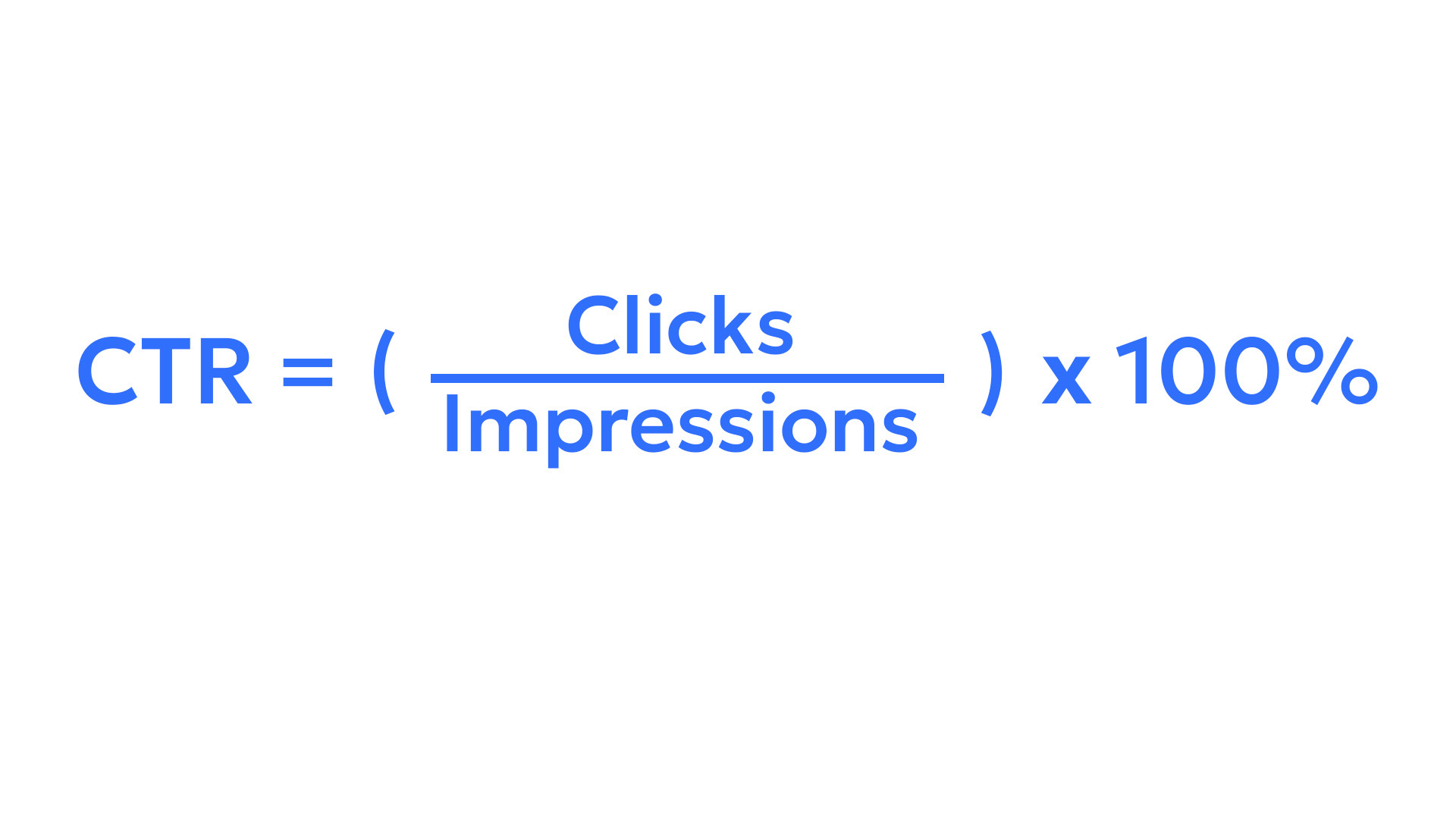
CTR directly reflects how well your snippet aligns with user intent and resonates with searchers. It’s not necessarily about the specific on-page elements like title tags, descriptions, or body text alone, but rather how appealing and relevant the entire snippet is to the query. When a snippet catches a user’s attention, he clicks, but if the visitor immediately leaves the page and returns to the search, it doesn’t indicate relevancy or quality.
What really matters is how the page’s content supports the formation of a relevant and attractive snippet. A well-crafted snippet, formed from relevant, well-structured content, can boost CTR and, by extension, SEO performance. The fewer bounces your page has and the more relevant it is to the user’s query, the higher it is likely to rank.
1. Title tags: the first thing that attracts the reader is the title. A compelling, clear, and relevant tag is the first thing to get a user. Consequently, the more closely your headline matches the search query and offers value, the more likely it is to result in a higher CTR.
2. Meta descriptions: a sentence that reflects the information of a given page. Why does it affect CTR? A well-written meta description acts as a call to action, giving users a reason to click on your result and not others—the more accurate the description, the higher the CTR.
3. Content relevancy: a user’s online query is not always a precisely worded search but often a description of a problem or a reflection of the information they seek. So, if the content is directly relevant to what the user is looking for, they are more likely to engage with the page. A high SEO CTR signals that your content meets the needs and expectations of the user, encouraging more visitors to explore your site.
NOTE: Google can change the title and description tags. Even if you specify particular text for these tags, Google may modify them, rearrange the words, or even select a snippet of text from your page and use it as the title.
As a result, CTR is not just any metric. It is one of the sources of information about the relevance of your content. A high CTR means that the title, description, and content are performing well and attracting users to your site. A low CTR, in turn, is a strong indicator that it’s time to focus on optimization to boost clicks and organic traffic.
2. Why CTR Complements Rankings in Measuring SEO Success
Rankings, one of the SEO performance metrics, show only part of the story. In turn, Click-Through Rate adds information to your analysis by showing how engaged a user is with your content.
Potential success vs. realized success
The ranking reflects where your web page appears in search results for specific queries, highlighting its visibility potential. However, visibility alone does not guarantee user engagement. For example, a page may rank at the top of search results but not attract clicks.
Here is where CTR becomes vital – it measures how often users click on your link after seeing it in search results. As a result, a low CTR represents a missed opportunity (even if the page ranks high), while a high CTR demonstrates SEO success. A strong CTR drives traffic, clicks, and, ultimately, sales.
So, what do you get? What is the relationship between the two metrics? Ranking lays the foundation for potential success, but CTR determines whether that potential is realized. Without tracking CTR, you’re only assessing where your page ranks, not how effectively it engages your audience.
Another important point to mention is that CTR is more than just a performance indicator; it’s a dynamic, user-centric metric that reflects how well your content meets users’ needs. Unlike rankings, which can remain static over time, CTR is fluid, providing real-time feedback on how users perceive and interact with your content.
Together, rankings and CTR provide a comprehensive view of the results of your SEO activities – visibility (rankings) combined with engagement (CTR). By optimizing CTR, you’re not abandoning ranking; you’re using it as a basis for achieving meaningful engagement. In modern SEO, CTR and ranking are complementary metrics that work together to ensure that your content not only appears in search results but also resonates with and serves your target audience.
3. CTR Signals to Search Engines
Why prioritize CTR in SEO? Because it matters to search engines, too. The clicks a page gets from search results don’t just show user interest—they also give search engines like Google valuable data to help them evaluate and adjust rankings. In other words, CTR signals how relevant your content is to users’ needs, and this behavior can influence how search engines rank your pages over time.
When a user clicks on a search result, the content matches their expectations or interests. It tells the search engine that the link is valuable and relevant. On the other hand, if users avoid clicking your link in favor of others, Google may interpret this as a sign that your content isn’t as relevant. Search engines increasingly use user behavior as a ranking signal, meaning the number of clicks can impact how Google perceives the relevance and quality of your content.
Google has clarified that user behavior plays a significant role in rankings. An antitrust case against the company revealed how Google uses behavioral signals in its algorithms. Specifically, when a page gets a higher CTR than others in the same position, it signals that the content is particularly valuable to users. It helps adjust rankings over time.
For instance, if Google sees users frequently clicking on your page for a specific search, it may conclude your content is more relevant than others and push your page up in the rankings. On the flip side, a low CTR might indicate that your page doesn’t match user intent, causing it to drop in the rankings.
In short, CTR acts as real-time feedback for search engines, showing whether your content resonates with users. It helps Google better understand relevance and quality, ultimately impacting how your pages are ranked.
4. Effective Strategies to Increase CTR with SEO Improvements
When we increase click-through rate (CTR), we improve SEO and increase organic traffic to the website. Improving CTR not only drives more traffic but can also positively influence your rankings in search engines.
How to improve CTR? Here are some effective SEO-driven strategies:
1. Craft Compelling Meta Titles
Your meta title is the first impression users get about the page in the SERPs. Optimize your titles by:
- Incorporating target keywords naturally, ideally at the beginning of the title.
- Using powerful words or emotional triggers like “Proven,” “Ultimate,” or “Secrets.”
- Keeping the title within 60 characters to avoid truncation in search results.
- Adding numbers or brackets, e.g., “10 Best Practices for SEO (2025 Edition).”
2. Write Engaging Meta Descriptions
Although meta descriptions don’t directly influence rankings, they are pivotal in enticing clicks. Focus on:
- Summarize the page content clearly and persuasively.
- Including your primary keywords to match search intent.
- Adding a call-to-action (CTA) like “Learn More,” “Read Now,” or “Discover How.”
3. Understand User Intent and Tailor Content to Meet Audience Needs
Improving CTR starts with aligning your content to the user’s search. Users are far more likely to click on your page when your content addresses their specific needs and interests. Here’s how to optimize for user intent:
- Identify the Search Intent
Begin by understanding the four main types of search intent:- Informational: Users seek knowledge or answers (e.g., “How to improve SEO”).
- Navigational: Users want to find a specific site or page (e.g., “Facebook login”).
- Transactional: Users are ready to purchase (e.g., “Buy iPhone 15”).
- Commercial Investigation: Users compare options before purchasing (e.g., “Best SEO tools 2024”).
- Create Problem-Solving Content
Craft your content to meet the user’s intent. For example:- For informational searches, provide in-depth, clear, and actionable information.
- For transactional searches, include strong CTAs, detailed product information, and pricing to drive conversions.
- Match User Expectations
Structure your content to align with users’ expectations. If they search for a “step-by-step guide,” format your page accordingly. For product searches, include easily accessible reviews, pricing, and specifications. - Use Search Queries to Guide Content Creation
Analyze the keywords and queries your audience uses. This insight allows you to craft content that addresses their needs, answers their questions, and provides clear solutions.
4. Optimize URLs for Readability
A clean and descriptive URL improves trust and signals relevance to users. Best practices include:
- Keeping URLs concise and keyword-rich.
- Avoiding unnecessary parameters or numbers.
Example of a good URL: https://yoursite.com/best-seo-tools
5. Leverage Rich Snippets and Structured Data
Rich snippets enhance your listing’s visibility by displaying additional information, such as reviews, prices, or FAQs. Implement schema markup to enable rich snippets for:
- Product ratings and reviews.
- Event dates and locations.
- Frequently Asked Questions (FAQs).
It makes your listing more visually appealing and provides additional context, increasing the likelihood of clicks.
6. Use Numbers and Lists in Content
Searchers often prefer content that promises actionable insights or steps. Adding numbers to your headings or promising list-style content can attract clicks. For example:
- “5 Tips to Improve Your CTR” or
- “Step-by-Step Guide to SEO Optimization.”
7. Focus on Mobile Optimization
With most searches happening on mobile devices, ensuring your content is mobile-friendly is crucial. Key improvements include:
- Using responsive web design.
- Optimizing page load speed for mobile devices.
- Ensuring clickable elements (like links or buttons) are easily tappable.
8. Target Long-Tail Keywords
Long-tail keywords often have less competition and a more specific search intent, leading to higher CTR. By addressing niche queries, your listing will more likely match what the searcher is looking for.
9. A/B Test Title Tags and Descriptions
Use A/B testing to experiment with other meta titles and descriptions to see what resonates most with your audience. Tools like Google Search Console can help track the impact of these changes on CTR.
10. Include Keywords in Headings (H1, H2, etc.)
Your headings should align with your title tag and reinforce the content’s relevance. It creates consistency between what users see on the SERPs and your page.
11. Use Eye-Catching Visuals for Featured Snippets
For queries where Google displays visual content (e.g., featured snippets or image packs), optimize your images by:
- Adding descriptive alt text with keywords.
- Using high-quality visuals that stand out in search results.
- Compressing images to maintain fast load times.
12. Capitalize on Emotional Triggers
Appeal to emotions like curiosity, urgency, or excitement in your meta titles and descriptions. Examples include:
- “Don’t Miss Out on These SEO Strategies!”
- “The Secret to Doubling Your CTR in Just 7 Days.”
13. Analyze and Improve Underperforming Pages
Use tools like Google Search Console and our SEO Analytics Reports to identify pages with high impressions but low CTR. Revisit these pages and enhance their meta titles, descriptions, and overall on-page content to align better with user intent.
By implementing these strategies, you can improve your SEO performance and achieve a noticeable increase in CTR, driving more qualified traffic to your site. Remember, continuous optimization and regular monitoring are key to sustaining long-term success in the ever-changing landscape of SEO.
5. Measuring and Monitoring CTR
Measuring and monitoring your click-through rate (CTR) is essential for understanding how well your pages perform in search results and making decisions about your SEO strategy. Constantly monitoring CTR identifies areas for improvement and tracks the effectiveness of your efforts. Several tools and metrics can help you monitor CTR and ensure your SEO tactics produce meaningful results.
Key metrics to monitor
Although CTR monitoring is important, understanding its context is also vital. To get the most out of your CTR data, you need to control key metrics that will help you analyze and optimize your content. Here are some of the most important indicators to keep in mind:
- Changes After Title/Meta-Description Updates:
- By tracking changes in the CTR before and after these updates, you can assess whether your optimization efforts yield results. If you see a noticeable increase in CTR after working on your titles or meta descriptions, it is a strong sign that these elements are successfully attracting more clicks.
- A/B Testing of headings and meta descriptions allows you to experiment with different approaches and determine which message works best for your target audience.
- CTR Comparisons Across Different Content:
- Not all pages or content types will generate the same level of engagement, so it is necessary to compare CTR between different types of content. For example, blogs, landing pages, product pages, and news pages will have different CTRs. By comparing these metrics, you can define patterns and optimize your content strategy to focus on formats and themes that attract the most clicks.
- Analyzing CTR by different content types also helps you to identify which areas need more attention and optimization.
- Impact Across Mobile and Desktop Views:
- Mobile optimization is vital because more users browse websites on their phones. It’s essential to check how your CTR compares between mobile and desktop. Differences often come from slow loading times, poor formatting, or missing mobile-friendly features.
- Tools like Google Search Console can help you track CTR separately for mobile and desktop. It makes it easier to spot problems and adjust your content to suit the devices your audience uses most.
- CTR for Branded vs. Non-Branded Queries:
- Branded searches refer to queries where users specifically search for your brand or company name, while non-branded searches are broader and don’t mention your brand directly.
- Tracking CTR for branded and non-branded searches shows how well your brand performs in search results and how effectively your content attracts new users. A high CTR for branded searches reflects strong brand awareness, while a high CTR for non-branded searches shows your content appeals to users seeking general information or solutions.
- To optimize, focus on both query types. For instance, creating content around non-branded keywords can attract new customers and expand your reach in specific niches.
- CTR for Different Ranking Positions:
- CTR is directly linked to your page’s position in search results. Generally, higher rankings lead to higher CTRs, but even a slight change in ranking can significantly affect your CTR.
- By tracking CTR for pages at different positions, you can see how it declines as rankings drop. For example, a page in the top spot may achieve a CTR of 25% or more, while one in the tenth position might only get 2-3%.
- This insight shows how rankings influence CTR and help you refine your strategy to boost rankings, especially for pages close to the top that have the potential to perform even better.
6. What is a “Good” Click-Through Rate?
How do you determine if the click-through rate (CTR) is ‘good’ in SEO? It’s not easy. There are metrics with universal benchmarks that are relatively easy to evaluate. And there’s CTR, which varies significantly depending on factors such as industry, search intent, query type, and the competitive landscape on the search engine results page (SERP).
Why does CTR vary a lot?
Many factors influence a “good” CTR:
1. Query intent. Informational queries might stop users from clicking on results if features like rich snippets and AI overviews provide enough answers. On the other hand, transactional or navigational queries usually lead to a higher CTR when the content matches what the user is looking for.
2. Content relevance. When your titles, meta descriptions, and content match what users are looking for, they are more likely to click on a link. Conversely, mismatched intent can lead to lower engagement, no matter how well a page ranks.
3. “Blue Links”. Organic links aren’t the only thing a user sees on the first page of Google. Rich snippets, AI-generated overview ads, image carousels, and videos compete for attention, which can reduce CTR for search results, especially on crowded SERPs.
4. Position in search results. The higher the ranking, the more clicks. It sounds logical, but it is not true. Even top positions can have different CTRs depending on the presence of competing SERP elements. For example, a result ranked at position one may perform worse if displayed under rich or next to attractive visual content.
5. Content Quality. Users prefer to click links that promise comprehensive, in-depth, or interesting information. What’s more, the quality of content helps hold a person’s attention, increasing engagement rates.
6. User Behaviour Signals. CTR is a direct feedback mechanism for search engines, reflecting users’ perception of your content. A consistently high CTR signals relevancy and quality to algorithms, potentially boosting your rankings over time. It creates a feedback loop in which improved visibility reinforces CTR, further increasing SEO effectiveness.
By considering all these factors, you can optimize your CTR to ensure your content not only ranks well but also captures meaningful user engagement.
So, if CTR is low, it can indicate several significant issues that need to be investigated:
- Irrelevant meta titles and descriptions: Ensure they communicate your value proposition and meet the searcher’s intent.
- Unattractive headlines: A well-optimized headline is key to attracting attention.
- Poorly targeted keywords: The content targeting the wrong audience will affect CTR.
In SEO, there is no specific number for a “good” CTR. It’s important to realize that you should compare your site’s CTR to yours! Focus on improving your performance by tracking your progress over time, understanding the peculiarities of your industry, and addressing specific factors that may be holding back your CTR.
CTR tracking tools
Several tools are available for tracking CTR, but two of the most common and reliable platforms are Google Search Console (GSC) and SEO Analytics Reports. These tools provide insight into your website’s performance in search results, help you evaluate CTR, and identify opportunities for optimization.
1. Google Search Console (GSC):
- GSC is an invaluable tool for tracking the CTR of your entire website. It provides detailed information about your site’s organic search results, including average CTR for individual pages, search queries, etc.
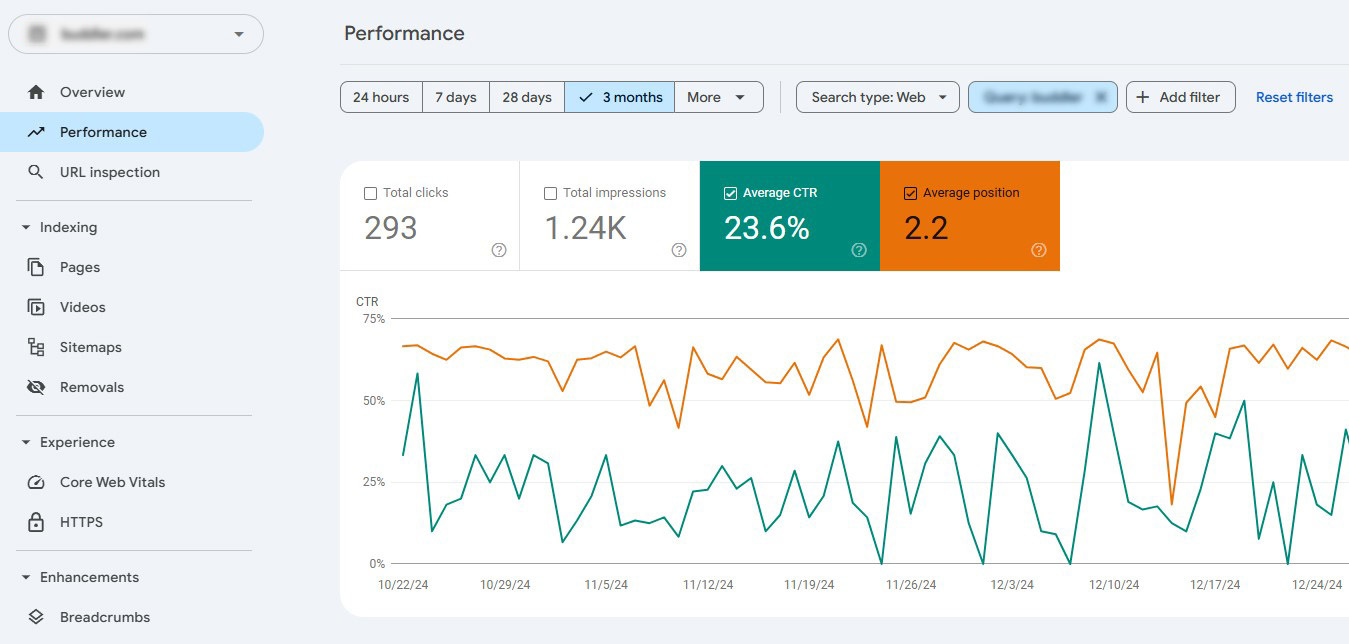
- With GSC, you can track each query or page’s impressions, clicks, and average position. It will allow you to see which keywords or pages are performing well and which could be improved in terms of CTR.
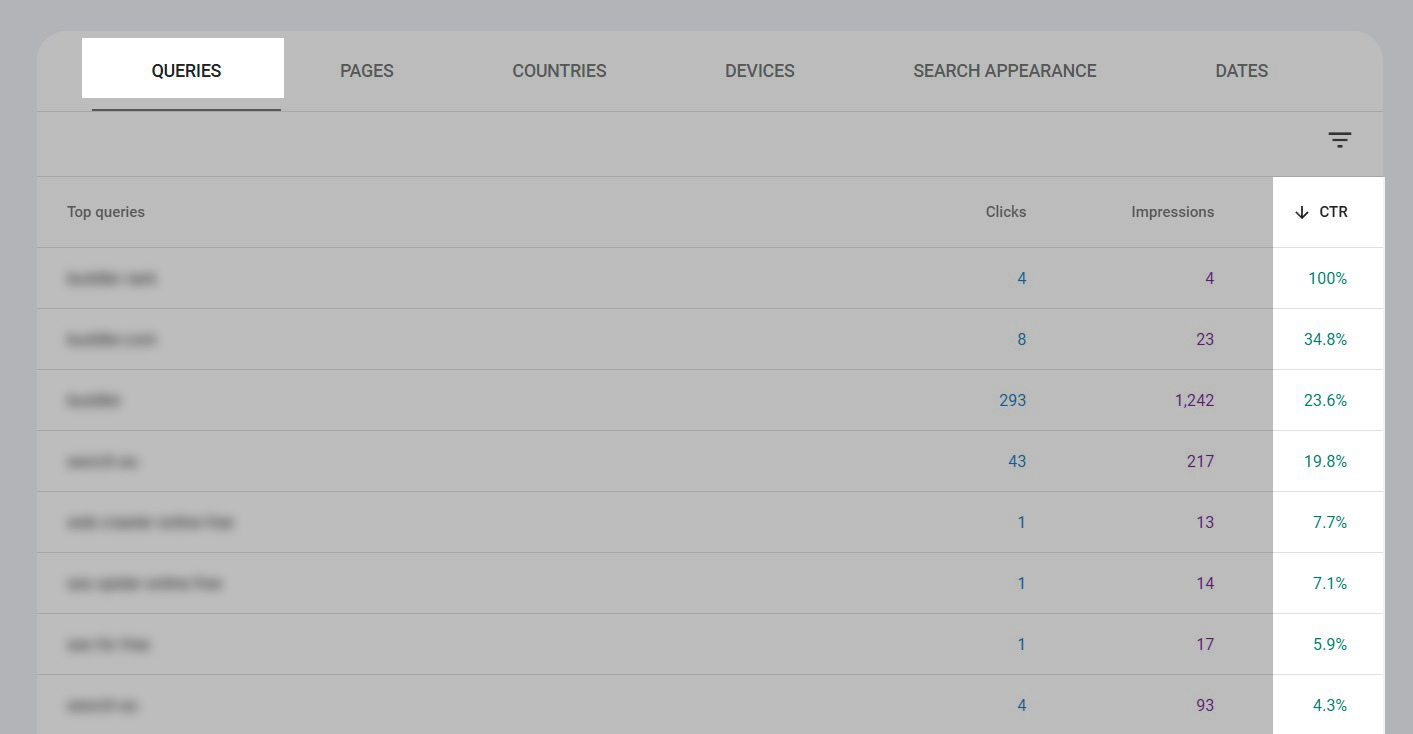
- GSC also allows you to track the impact of specific site changes, such as updating titles and meta descriptions, and see how these changes affect CTR over time.
2. SEO Analytics Reports:
- SEO Analytica Reports is another tool that helps you track CTR. It focuses on competitor performance and helps you understand what works best in your SEO strategy. It helps you identify which pages bring in the most traffic and provides detailed data on CTR, keyword rankings, and user behavior.
- This tool is particularly useful for tracking CTR trends and conducting competitive analysis. It helps you understand how your CTR compares to others in your niche and identifies areas where your site can outperform the competition.
7. Buddler SEO CTR Benchmarks Report
The SEO CTR Benchmark Report is part of a comprehensive SEO Analytics Reports by Buddler. Users gain insights into their website’s CTR performance through three distinct tabs within the report:
1. Historical Losses: Queries with Dropped CTR
The first report identifies queries for which the CTR has dropped compared to historical data. The report highlights the precise volume of traffic lost due to the decline by comparing the current CTR with peak historical performance.
This insight answers critical questions:
- Were there changes in page titles, descriptions, or other metadata that may have impacted engagement?
- Have competitor strategies evolved, affecting your visibility or appeal?
- Is the page content still relevant to the audience and search intent?
Once identified, you can address these losses by restoring the elements that previously drove clicks. It might include updating metadata, adjusting content to align with current user intent, or improving page load speed and design. Even recovering a small portion of the lost traffic can significantly improve your site’s performance.
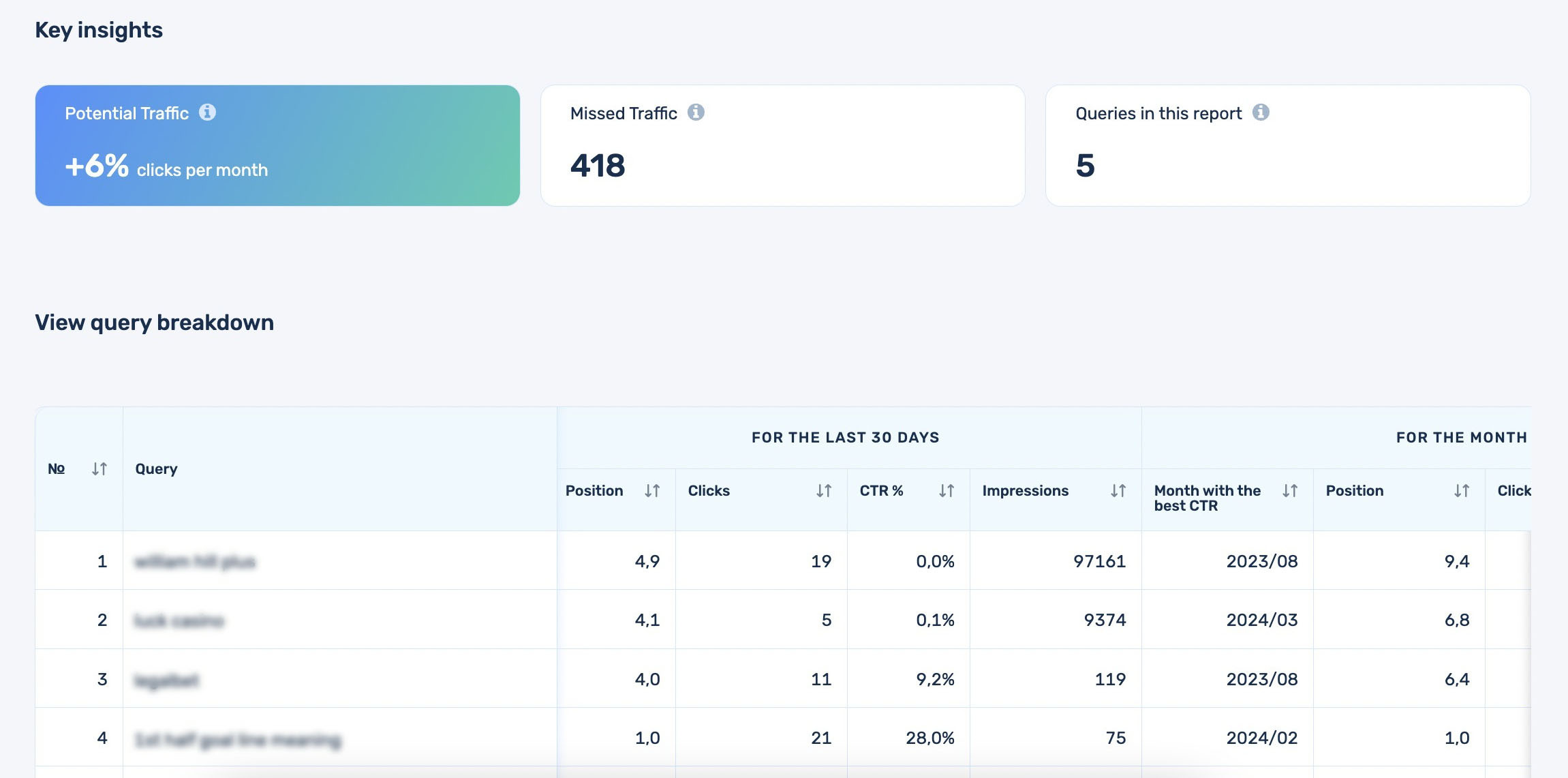
2. Current Risks: Queries with Unusually Low CTR
This report focuses on queries whose CTR is unusually low for their position. For example, a query ranking in the top three positions but underperforming in CTR compared to similarly ranked queries on your site signals a red flag.
Here’s how the report helps address current risks:
- It pinpoints anomalies in CTR for specific queries relative to your site’s internal benchmarks.
- It identifies problems such as poorly optimized metadata, irrelevant content, or a mismatch in search intent.
Low CTR for high-ranking queries often indicates deeper issues that could impact rankings in the future. Search engines may demote pages that fail to attract user engagement, further compounding the issue. By acting swiftly on these insights, you can prevent potential losses before they occur.
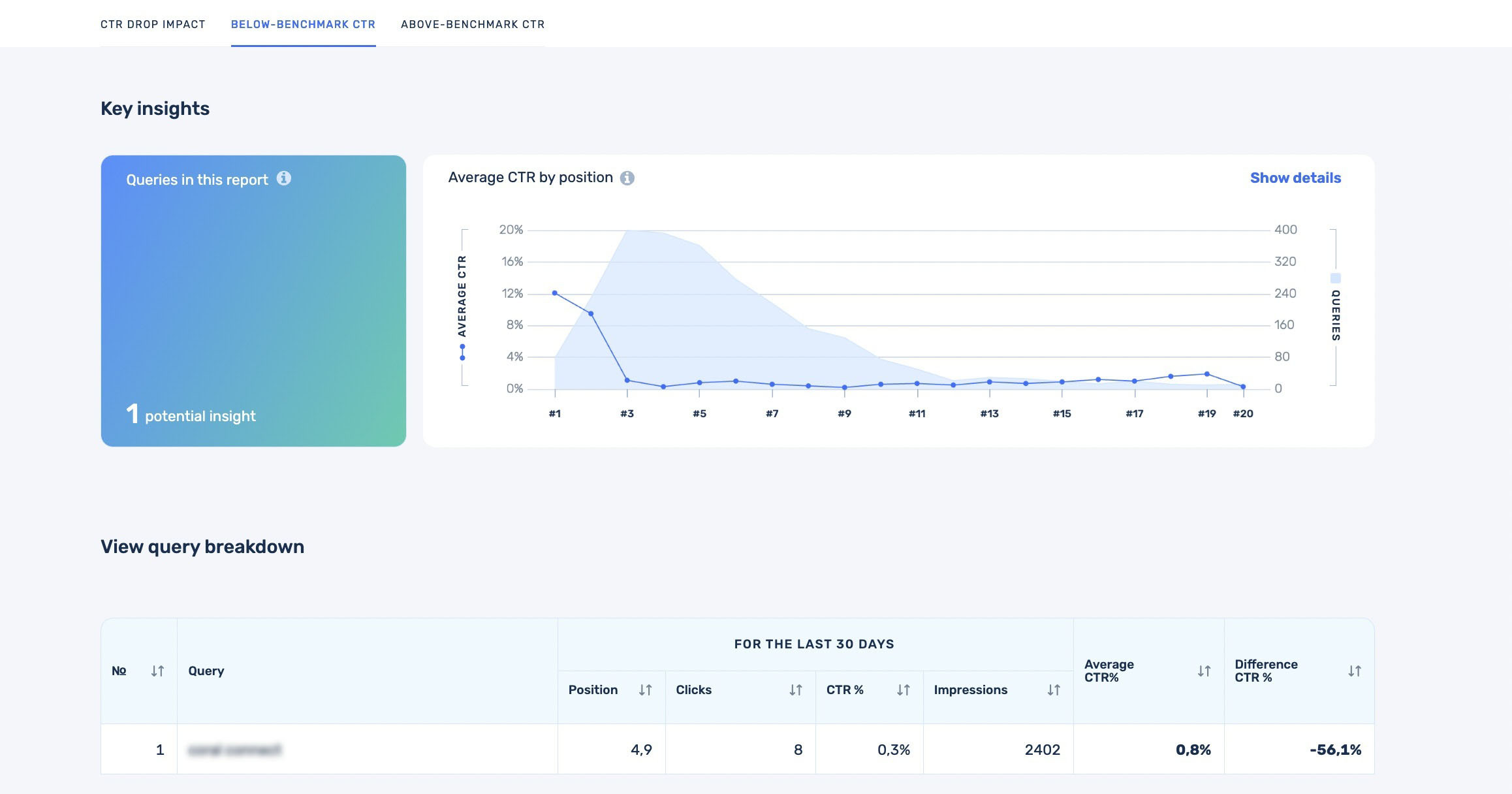
3. Queries with Exceptional CTR Opportunities
The third report highlights queries that are already performing well but have the potential to achieve even greater results. These “hidden gems” often include queries with above-average CTR for their position, indicating that users find the metadata or content highly engaging.
Key opportunities include:
- Optimizing for Even Higher CTR: Update titles, descriptions, and structured data to build on your success.
- Replicate Success Across Similar Queries: Use what works for high-performing queries to improve others.
- Boosting Ranking Potential: A high CTR shows search engines that your content is relevant, which can help improve your rankings..
By leveraging these opportunities, you can turn good performance into exceptional results, ensuring your website captures as much traffic as possible.
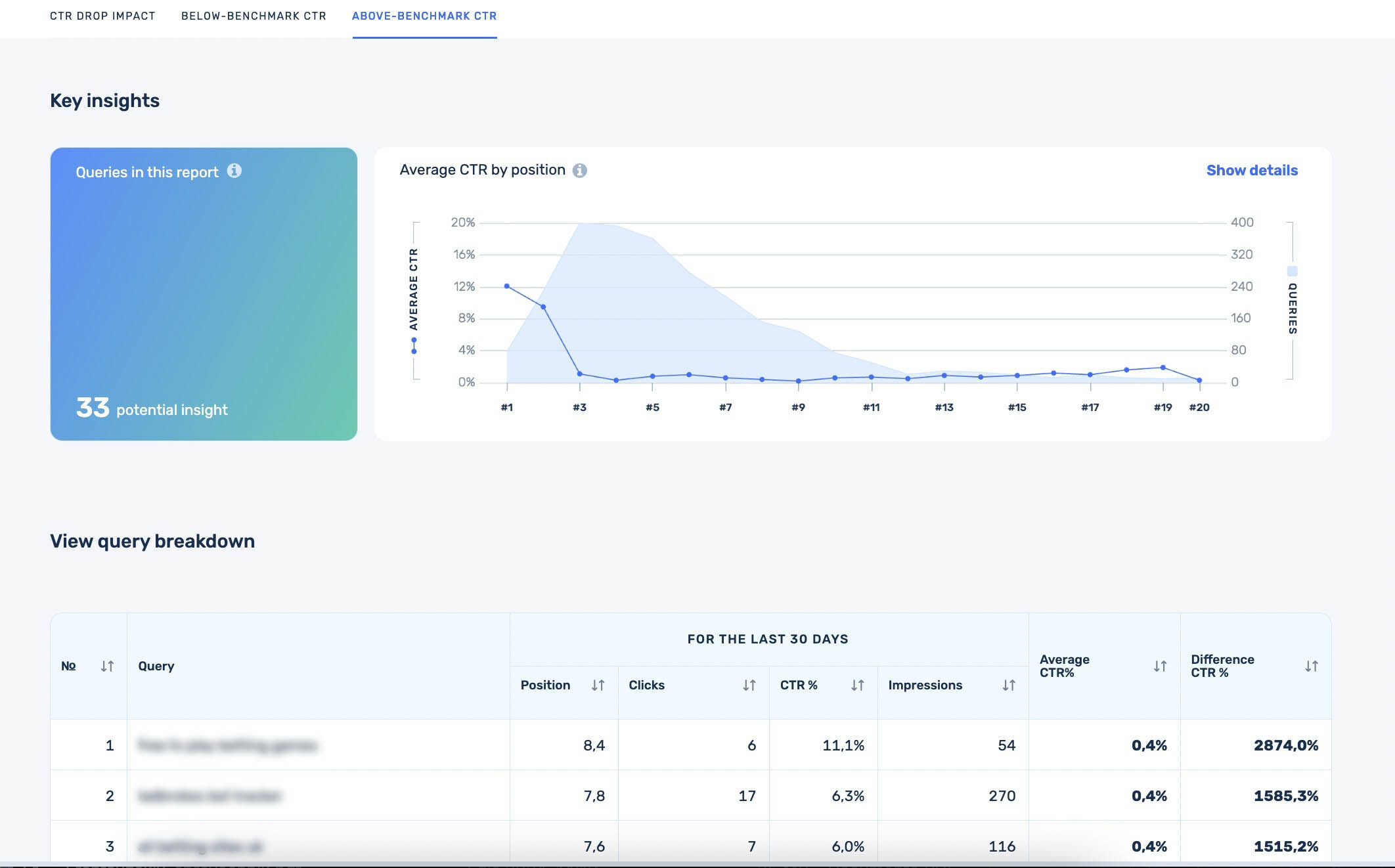
A New Perspective on CTR Analysis
Traditional CTR benchmarks often compare performance with industry averages or competitor data. However, Budder uses a different approach: self-comparison. Focusing on historical data and current trends, this tool provides practical information adapted to the website’s specific characteristics.
Key benefits of this methodology include:
- Personalized Analysis: The system adapts insights to your website for more accurate and relevant results.
- Avoiding Incorrect Metrics: Buddler removes errors by not relying on general comparisons.
- Actionable Insights: It pinpoints areas to improve, helping SEO professionals focus on what matters most.
8. Analyze CTR Anomalies to Refine SEO Strategy
Keeping an eye on unusual changes in your Click-Through Rate (CTR) is essential for understanding how users engage with your content. A sudden drop or spike in CTR can reveal important details about how well your SEO strategy works and whether your content meets user expectations.
By analyzing these changes, you can uncover problems that need fixing or spot new opportunities to improve your site’s performance. This approach helps you keep your SEO strategy effective and your content aligned with users’ needs.
What are CTR Anomalies?
Click rate anomalies (CTRs) are unusual patterns or significant deviations in CTR data that do not meet expected or historical norms. In this context, anomalies refer to unusually high or low CTRs that cannot be easily explained by regular seasonal changes, marketing campaigns, or other predictable factors.
These anomalies can happen for various reasons, including:
- Technical Issues: Errors in tracking systems, broken links, or problems with rendering in search engine results can artificially inflate or deflate CTR numbers.
- Content Shifts: If a website’s content drastically changes or a new topic, keyword, or piece of content is introduced, CTRs might spike or drop unexpectedly.
- Algorithm Updates: Search engine algorithms (such as Google’s) can update frequently, affecting rankings and visibility and leading to unusual CTR patterns.
- Competition: Increased competition, particularly through paid ads or higher-ranking organic results.
- Seasonal or External Events: External events (like holidays or news events) can impact user behavior and cause CTR anomalies.
- User Behavior Shifts: A change in how users interact with search results—such as more clicks on featured snippets, images, or video results—can alter CTR trends.
Why Analyzing CTR Anomalies Matters
Regularly analyzing anomalies allows you to adapt quickly. Whether facing a drop in CTR or experiencing a spike, understanding the root cause helps refine your content strategy and enhance search visibility.
Here’s how you can effectively analyze and respond to CTR anomalies:
- Spot Content Issues: A drop in CTR could mean your content is no longer attractive or relevant, while a spike might indicate increased interest due to a trend or a change in search behavior.
Action Tip: Identify pages with sudden changes to the CTR and assess whether they need updated content, improved headings, or better formatting to meet users’ expectations. - Understand Shifts in User Behavior: Changes in CTR often reflect evolving user intent. For example, a trending topic might boost CTR, while outdated content could lead to a decline.
Action Tip: Regularly review keywords and trends to ensure your content meets current user needs. Add value by answering emerging questions or providing up-to-date information. - Improve Content Relevance: Drops in CTR after algorithm updates may signal that your content no longer meets ranking criteria or user expectations.
Action Tip: Revisit affected pages and optimize for the latest ranking factors, such as aligning with E-A-T (expertise, authority, and trustworthiness) guidelines or enhancing keyword targeting.
9. Conclusion: Focusing on people, not just search engines
CTR is not just another number in your analytics dashboard; it’s a steady rhythm that keeps your SEO efforts alive. It’s like a little nod of approval from your audience: every click is a small confirmation that your content, message, and proposal have been well received. And when search engines see this involvement, they respond.
Sure, ratings are important – they put you on stage. But CTR? That’s what keeps you in the spotlight. It’s the real indicator that your message has reached people, that your SEO strategy is working, and that your efforts create value for real people.
So, if there’s one thing I’ve learned, it’s this: never underestimate the power of a well-crafted headline, an engaging meta description, or an intuitive design. These seemingly insignificant details are crucial. They are the secret sauce for turning rankings into real results and data into meaningful connections.
SEO is a journey, not a destination; CTR is your compass. Follow it, improve it, and let it lead you not just to more traffic but to the right traffic – your audience. Because at the end of the day, it’s not about clicks but connection. And isn’t that what great SEO is all about?
